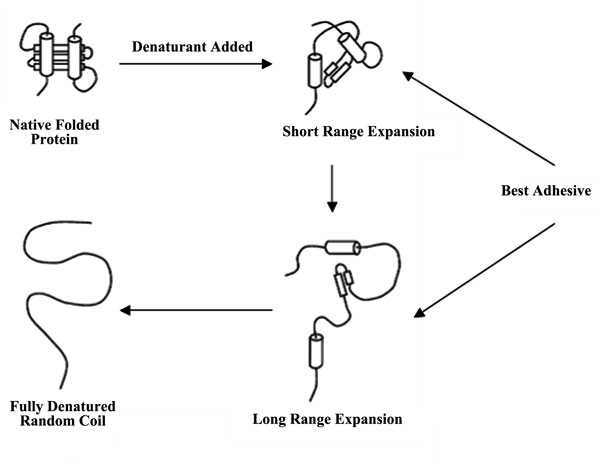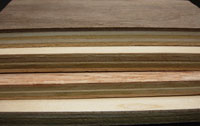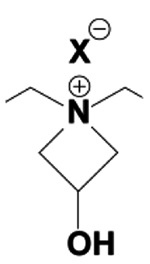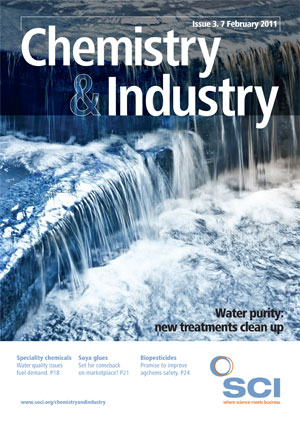Soya beans have long been considered a miracle crop for their ease of growing; high concentration of vegetable oil and high protein content; and their ability to reintroduce nitrogen back into the soil. The origin of soya beans dates back to the early 11th century from the eastern half of China. They were introduced to Europe in 1712 and first harvested in the US in 1764. With the advent of the combine harvester, soya bean growth exploded in the US from 1929 to 1939, increasing from 0.23m to 2.25m t.1

Soya adhesives
The first US patent for soya bean adhesives was issued to researcher Otis Johnson in 1923, although in fact it was the American industrialist Irving F. Laucks who pioneered the development of soya bean-based glues in the early years of the 20th century.3 Laucks began selling his soya bean glue in 1923 as an improvement over the often-used casein glue systems. Although not durable outdoors, soya bean glues were considered to be acceptable for most interior applications. By 1927, most of the plywood industry was using Laucks’ soya adhesive formulation, but the industry was still plagued by durability issues and the inability to perform under exterior conditions. This severely limited the growth opportunities for the plywood industry.


Water-durable glue
Adhesive developers and formulators began modifying their adhesives with various additives as a result of a new commercial standard adopted in 1938. The partial replacement of sodium with calcium, along with the addition of sodium silicate, was the most common approach. Soon afterwards, the addition of blood protein to the soya adhesive formulation became important.5 This improved the water resistance of plywood panels and, most importantly, improved the performance of the glue-line such that it was capable of passing the new standard. Although the odour of blood made this an unpopular choice, the inclusion of blood into soya formulations was well accepted and proved to be a very successful solution for 25 years.

Urea-formaldehyde (UF) adhesives were first introduced in 1937, but soya and soya–blood still enjoyed the dominant position for interior panels for the next 20 years. It was not until the late 1950s that UF glues began to supplant soya adhesives on a routine basis. These fossil fuel-based adhesives – urea from natural gas and formaldehyde from methanol – simply became much easier to use; they enjoyed longer pot lives, less colour, higher solids, and lower viscosity, along with a lower price. By then, UF adhesives were the clear choice for interior panel producers and soon led to the nearly complete demise of soya bean use in wood adhesives.

Soya bean re-birth
Through the early years of UF chemistry, it became well accepted that the more formaldehyde in the formulation, the better and faster the UF adhesive would perform. Unfortunately, this discovery also led to higher emissions of formaldehyde from the final product. The use of UF glues in interior applications led to health concerns over formaldehyde emissions from these products. Thus, beginning in the 1970s and continuing through today, the acceptable level of formaldehyde emissions from composite panels has been decreasing. This culminated in the 2007 California Air Resource Board's (CARB) acceptance of vastly reduced emissions levels for any panel sold in the state of California.6
In July 2010, the US Congress passed a law that essentially makes the CARB levels a national standard by the year 2013. These formaldehyde emission concerns, coupled with higher fossil fuel prices, have led to a renewed interest in the development of better performing and lower cost soya-based adhesives.
In 1998, Roland Kreibich at Kreibich Associates discovered that highly denatured and partly hydrolysed soya flour-based adhesive, termed soya hydrolysate, was a highly effective ingredient in a two-part system for wood finger joint bonding. This process, commonly referred to as the ‘honeymoon’ system, applied a phenol resorcinol formaldehyde (PRF) on one side and the soya hydrolysate on the other, then joined the pieces together at room temperature to form a very strong and durable bond, even with undried wood.7
With the price of phenol skyrocketing in the early 2000s, this was an opportunity for a partial replacement of phenol formaldehyde (PF) with a low cost soya-based extender. Several groups showed the potential for this technology. However, soon afterwards, the price of phenol dropped precipitously. It is expected that when the global economy recovers and the price for the petroleum-based phenol increases, some of these soya bean adhesive extender technologies will become commercially successful. In 2002, Kaichang Li from Oregon State University, US, discovered that when soya flour was combined with a well known paper wet strength additive, polyamidoamine epichlorohydrin (PAE), the ‘wet strength’ of the adhesive – a measure of how well the bond performs when wet – was substantially improved.
Most importantly, the bond durability using this technology was suitable for commercial production of interior plywood while meeting all of the current performance standards. These glue-line durability requirements are very similar to those first introduced in 1938, but the reintroduction of the early solution of blood inclusion is very unlikely today!
The PAE-soya discovery was considered to be a huge step forward in adhesive technology offerings, not only in the development of a primarily bio-based adhesive, but also of a new formaldehyde-free adhesive. A patent was issued on this application in 2007. The use of formaldehyde-free adhesives is essential to the production of ‘no added formaldehyde’ (NAF) panels, a new classification of low-emitting composite panels.
The soya-PAE chemistry is based on the reactive functional azetidinium of the PAE polymer. The azetidinium ion (Figure 2) is capable of reacting with several side groups of the protein amino acids, which make up the protein. One proposed bonding mechanism involves the reaction of PAE with the amine end group of the amino acid lysine in soya flour. The amount of PAE in the formulation is dependent on both the desired degree of water resistance needed and also on the product composition. Typically the PAE is added at levels from 10 to 30% of the total solids of the formulation.
US chemical company Hercules was the producer of PAE and obtained the exclusive rights to the resulting so-called Li technology. In 2005, the largest hardwood plywood producer in North America, Columbia Forest Products (CFP), began converting all of its commercial operations over to this new soya-PAE system. Today, CFP has completed the conversion of all of its facilities and sells the panels under the Purebond trademark. In 2006, Hercules partnered with the soya adhesive specialist, Heartland Resource Technology, to advance this technology and to develop a line suitable for applications in the particleboard and medium density fiberboard markets. Ashland acquired Hercules in 2008 and today sells a soya adhesive product line under the trade name of Soya d. The Soya d technology now includes both PAE and non PAE-based technology and has experienced significant growth and technical advancement.
The soya–PAE adhesive is very homogeneous, lightly coloured and opaque. One of the challenges of working with soya flour in any soya formulation is the shear-thinning nature of the adhesive; that is, the adhesive’s viscosity decreases as the shear rate increases. Many of the systems are also thixotropic – they thicken when not agitated – which can lead to pumping or transfer issues if process controls are not rigorously followed. The picture on page 22 demonstrates the excellent bond quality of a variety of different engineered wood flooring compositions; shown after being subjected to the three-cycle soak and dry test.
The Soya d progression in particleboard and MDF has been slower than for plywood because of the more restrictive processing requirements of low viscosity, so it can be spray applied, and high solids content. The latter is a result of a need to minimise total mat moisture going into the press to avoid excessive gas pressure build-up and panel delamination when the press opens.
Typically, in addition to the modified soya flour and PAE, Soya d for PB and MDF also contains a dispersion diluent to aid in the solvation, distribution, and total solids of the final formulation. Soya has also been shown to function as an effective extender/coadhesive with poly(vinyl acetate) (PVAc) adhesives. Franklin recently introduced8 Multibond MX-100 and Hexion has successfully commercialised its Ecobind adhesives, which combine soya with PVAc and PF.
Other work in this space includes novel soya bean-modified adhesives or a co-adhesive system.9,10 Although these approaches have not yet enjoyed the commercial success of the Li invention, they do exemplify the large activity and options that exist today in the exciting area of soya bean-based glues.
James Wescott is technical director of Wood Adhesives at Heartland Resource Technologies, Waunakee, Wisconsin, and Charles Frihart is research scientist at Forest Products Laboratory, Madison, Wisconsin, US.
References
1. Liu, K., Soybeans - chemistry, technology and utilization, chapt 2; Aspen: Maryland, 1999.
2. Martin, J. Presentation at United Soybean Board Technical Advisory Panel, St. Louis, MO, US, 2009.
3. Cour, R., The Plywood Age; Binsford and Mort: Portland OR, 1955.
4. Lambuth A., Protein Adhesives for Wood. In: Handbook of adhesive technology, 2nd ed, p. 457- 478. Eds. Pizzi, A., Mittal, K.L. Marcel Dekker, New York, 2003.
5. Lamburth, A., Blood glues, in Handbook of Adhesives, 2nd ed, pp. 181-191. Ed. Skeist, I. Van Nostrand Reinhold: New York, 1977.
6. ATCM. (2009) Airborne Toxic control measure to reduce formaldehyde emissions from composite wood products. Health and Safety Code: Title 17 California Code of Regulations, Section 93120-93120.12.7.
7. Kreibich R., Steynberg P., and Hemingway R., End jointing green lumber with soy bond: wood residues into revenue: residual wood conference proceedings, 4-5 November 1997, pp. 28-36. MCTI Communications: Richmond, BC., 1998.
8. Biobased solutions, United Soybean Board, vol 12(6), 2010.
9. Thames, S. et al, Soy protein adhesives and uses thereof, U.S. Patent Appl. 12/586,739, 2010.
10. Kuo, M. et al, Soybean-based adhesive resins and composite products utilizing such adhesives. U.S. Patent 6,306,997, 2001.





